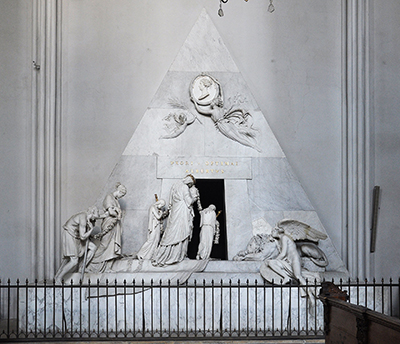Maria Christina was the Archduchess of Austria and she became the subject of this funeral monument by Antonio Canova which was to be placed in the Augustinian Church in Vienna, Austria. It is the triangular shape which is the most memorable element to this particular piece.
The sculptor would work on this project from 1789 to 1805, though these years were also devoted to other projects as well. The figures included within this design are essentially escorting the Archduchess off to her resting place and providing her with support on her final journey. There is almost a timeless quality to this piece, as if she will for eternity remain on this journey because of how the other figures have been incorporated into the design. A number of respected artists around during Canova's lifetime, or soon after, would produce drawings of this popular creation. It wowed local Austrians and several etchings were released from some of these highly detailed sketches. That would make it possible for more people to enjoy this sculpture within their own homes through cheap prints which could easily be produced from the original engraving. Pietro Bonato, a prominent printmaker at the time would take a drawing by Domenico del Frate in 1805 and roll off a series of prints, one of which can be seen today within the Rijksmuseum in the Netherlands.
Duke Albert von Sachsen-Teschen decided to call upon the services of Canova in mid-1798 in order to produce a fitting monument that would properly celebrate the life of his wife, Archduchess Maria Cristina of Austria who had passed away earlier in the year. Canova had already come up with the idea of a pyramid design for a monument that would have celebrated the life of Titian, though that project was never completed and so he decided to use that same idea for this project instead. There is a winged funerary genius to the right hand side who looks unconsolable as the body is carried away to its final resting spot. That figure leans over a lion whilst crying uncontrollably. It carries a decorative shield by its side which contains some stunning detail carved into its front which you would not be able to see without visiting the piece in person. Canova produced several tombs during his career but this monument differs in how the items are arranged together, providing an important source of variety within his overall oeuvre.
Canova would become a household name across the regions of Italy during his own lifetime and this reputation would spread abroad across Europe as a result of the huge influence which art from this nation had over the rest of the continent. Canova was ambitious and open-minded, seeking to take on as many high profile challenges as possible, and also willing to avoid limiting himself to certain genres of work, even if he discovered that he could work within them successfully. This level of ambition helped him to stand out at the time, particularly when combined with his high levels of flair and innovation which ensured he was bringing in new ideas rather than just being a technically proficient copyist, and others may sometimes be labelled. He sits alongside the great names of Italian sculpture and remains highly regarded all these years later.




